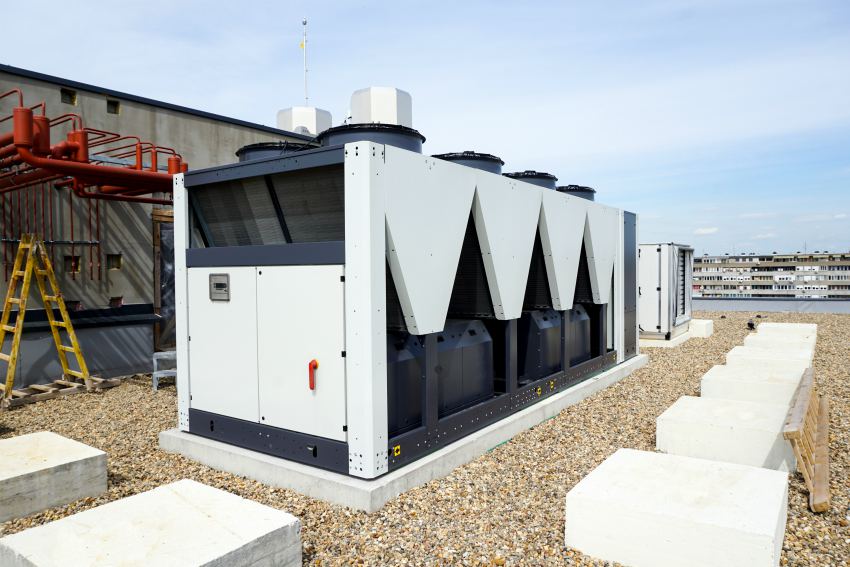05 August 2019
|
| Andrew Slater looks forward to a return of increased options for the air conditioning market. It is only through choice that a competitive market place is possible. Driven through innovation and steered generally by legislation, we have seen the HVAC industry consistently progress to be more energy efficient and increasingly more environmentally friendly. |
The refrigeration and air conditioning sectors have always been quite different, especially since the rise of the VRF system. Inverter technology, flexible design options and smaller plant space requirements saw the application of small chillers rapidly replaced by the all-inclusive VRF. Now it seems that through a lack of choice the pendulum is perhaps swinging back, through changes in building certification, legislation with regards to leak detection, an increase in modular chiller capabilities and the F-Gas phase down.
Whilst including flexible design capabilities and packed with cutting edge technologies, the air conditioning sector appears to be somewhat stuck for the moment because of a lack of viable options for refrigerants. The chiller market, in contrast, has taken the initiative of offering an array of options. The priority of capital cost, operating cost or environmental benefit has been given to the customer as a choice when selecting a chiller.
The selections of available refrigerants for each application, such as R452B, R454B, R513A and R1234ze, plus multi refrigerant compressors, have made this possible. It is important that we understand that most of these refrigerant options are only intermediary and emphasis should be on transitioning towards ultra low GWP options to meet F-Gas phase down targets, but even so there is still a choice.
Short-term solutions
Through extensive marketing, the air conditioning sector seems to have been steered towards R32 as a lower GWP alternative to R410A. As a 50% component of R410A, the continued emphasis on launching R32 product ranges will eventually lead to a loss of available options for servicing the extensive number of VRF systems currently operational without exceeding refrigerant quotas.
In addition, R32 air to water heat pumps have also been introduced into a rapidly growing domestic market. Should we have used this potentially mass market in its infancy to implement the relatively large design changes in order to accommodate ultra-low GWP refrigerants? Or are we simply looking at short-term solutions with short-term gain?
It is still important that the industry focuses on recycling refrigerant to work around quotas and provide service options for existing equipment, even though the research carried out by Honeywell to find alternative refrigerants for R410A has been refreshing. First R466A, as a short-term solution to rival R32, and now development work on the longer term HDR-147 is taking place.
There are still some concessions that need to be made in terms of building regulations to return VRF to a more solid proposal, but hopefully now the air conditioning sector is moving towards having design choice once again.
Whilst including flexible design capabilities and packed with cutting edge technologies, the air conditioning sector appears to be somewhat stuck for the moment because of a lack of viable options for refrigerants. The chiller market, in contrast, has taken the initiative of offering an array of options. The priority of capital cost, operating cost or environmental benefit has been given to the customer as a choice when selecting a chiller.
The selections of available refrigerants for each application, such as R452B, R454B, R513A and R1234ze, plus multi refrigerant compressors, have made this possible. It is important that we understand that most of these refrigerant options are only intermediary and emphasis should be on transitioning towards ultra low GWP options to meet F-Gas phase down targets, but even so there is still a choice.
Short-term solutions
Through extensive marketing, the air conditioning sector seems to have been steered towards R32 as a lower GWP alternative to R410A. As a 50% component of R410A, the continued emphasis on launching R32 product ranges will eventually lead to a loss of available options for servicing the extensive number of VRF systems currently operational without exceeding refrigerant quotas.
In addition, R32 air to water heat pumps have also been introduced into a rapidly growing domestic market. Should we have used this potentially mass market in its infancy to implement the relatively large design changes in order to accommodate ultra-low GWP refrigerants? Or are we simply looking at short-term solutions with short-term gain?
It is still important that the industry focuses on recycling refrigerant to work around quotas and provide service options for existing equipment, even though the research carried out by Honeywell to find alternative refrigerants for R410A has been refreshing. First R466A, as a short-term solution to rival R32, and now development work on the longer term HDR-147 is taking place.
There are still some concessions that need to be made in terms of building regulations to return VRF to a more solid proposal, but hopefully now the air conditioning sector is moving towards having design choice once again.
- Andrew Slater is managing director of HVAC Communications.
Content continues after advertisements








